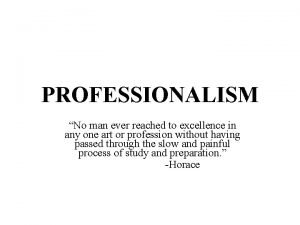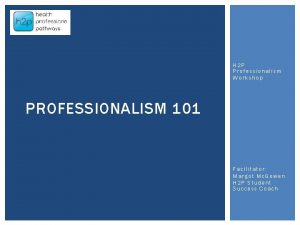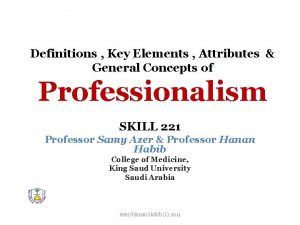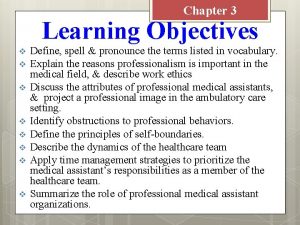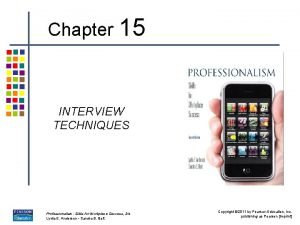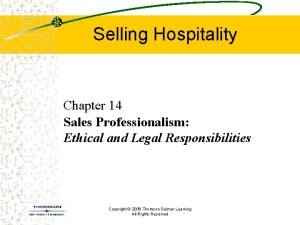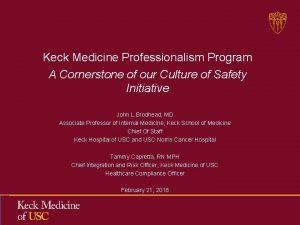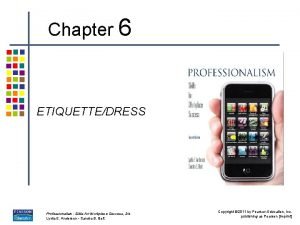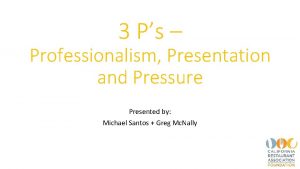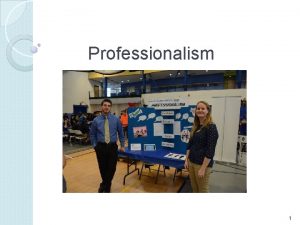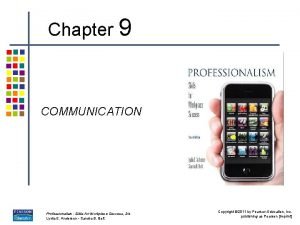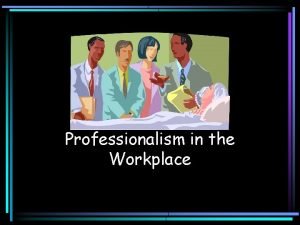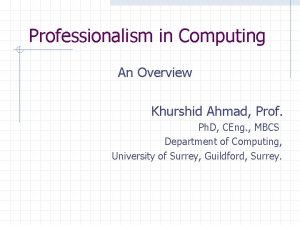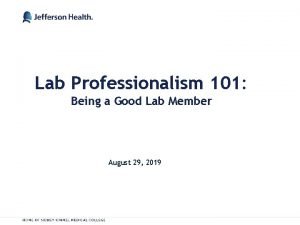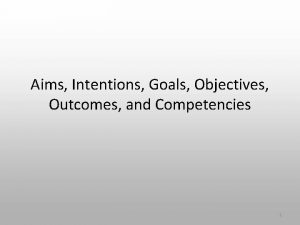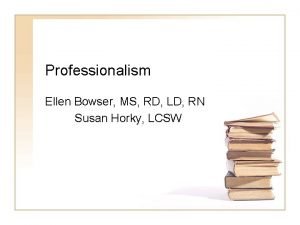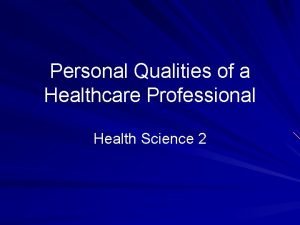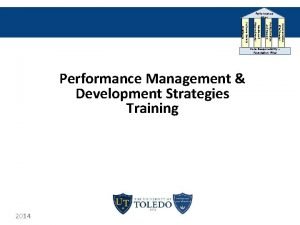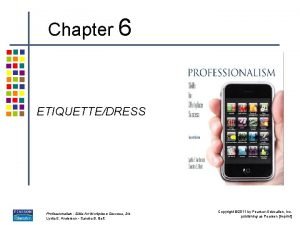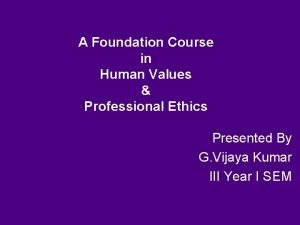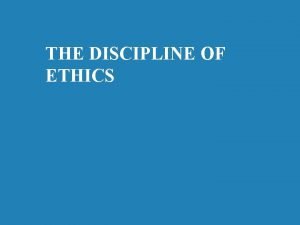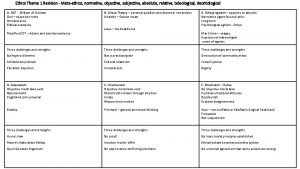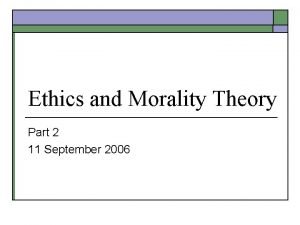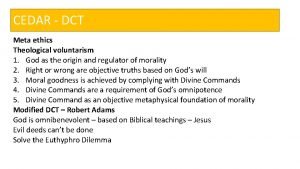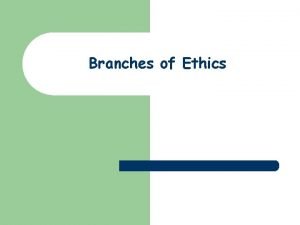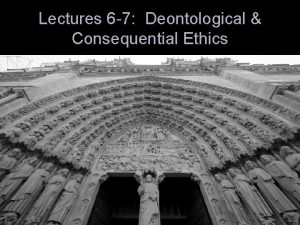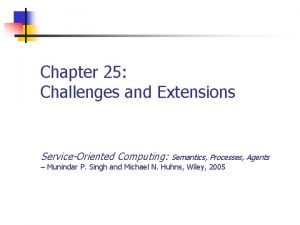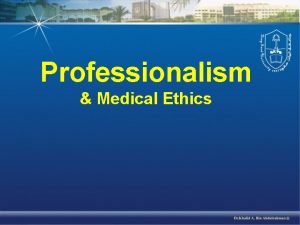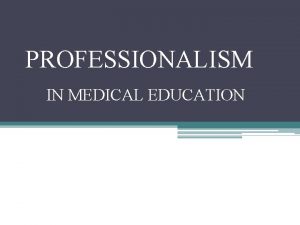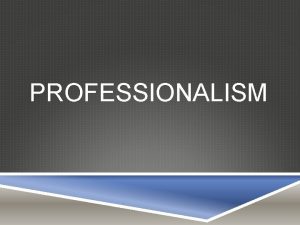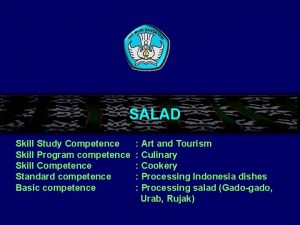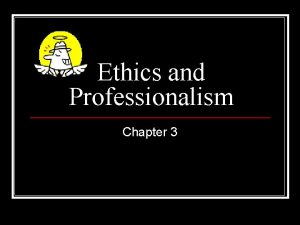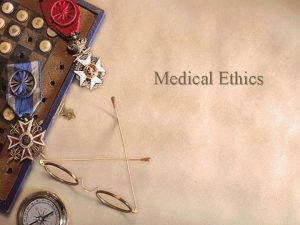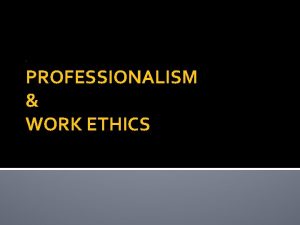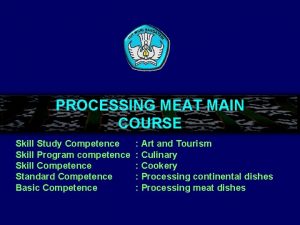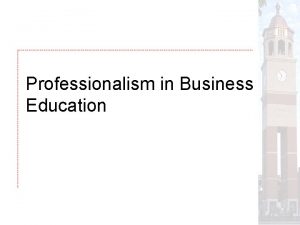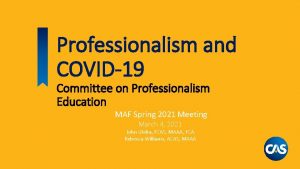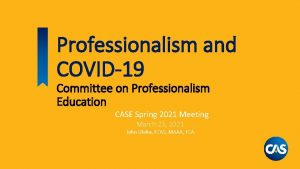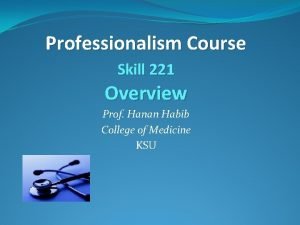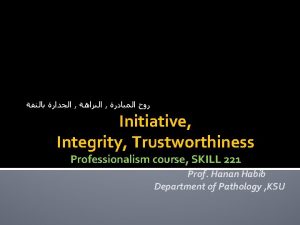PROFESSIONALISM ETHICS IN MEDICAL EDUCATION Study Skill Course



















































- Slides: 51

PROFESSIONALISM & ETHICS IN MEDICAL EDUCATION Study Skill Course Medical Education Department College of Medicine

Think of some Excellent Teachers who Influenced your Learning. Mention Some of Their Qualities and Attributes

OBJECTIVES ● Define Professionalism. ● Identify some professional & unprofessional behaviors. ● Recognize as an important part of the curriculum.

CONTENTS: ● ● ● What is professionalism? What are Unprofessional behaviors? How can we Implement it in the Curriculum? How can we Teach/learn it? How can we Assess it?

What does professionalism means to you? • Take two minutes and write down your thoughts … as a definition or description

What is Professionalism? • It is not easy to define a profession, but it is likely to have all or Some of the following characteristics: – It is a vocation that implies service to others. – It has a distinctive knowledge base which is kept up to date. – It determines its own standards. – It has a special relationship with those whom it serves e. g. patients. – It has particular ethical principles

Professionalism in Curriculum • General Medical Council 1993 • AAMC Medical School Objectives Project (MSOP) 1999 • ACGME Outcomes Project 2000 • Can-MEDS 2000 • KSU medical College Outcomes 2009

WHAT MEDICAL COLLEGES WANT? • Proficiency • Communication skills • Interpersonal skills • Confidence • Critical thinking & problem solving skills • Flexibility • Self motivation • Leadership • Teamwork

Professionalism is a term which embodies numerous qualities of physicians as public servants.

It has been described by The American Board of Internal Medicine as: “Constituting those attitudes and behaviors that serve to maintain others interest above physician Self-interest”


'Project Professionalism' (ABIM, 2001) Identified six key elements of professionalism: 1 - Altruism 2 - Accountability 3 - Excellence 4 - Duty 5 - Honor and integrity 6 - Respect for other

Main Characteristics of professional conduct (by the American Board of Internal Medicine) § ALTRUISM is the essence of professionalism. The best interest of the patients, not self-interest, is the rule.

§ACCOUNTABILITY is required at many levels: individual patients, society and the profession.

§EXCELLENCE entails a conscientious effort to exceed normal expectations and make a commitment to life-long learning

“It will become increasingly difficult for professions to sustain the policy that qualification is for life. Most professionals need to make a commitment to lifelong learning”. Professor Eraut.

§DUTY is the free acceptance of a commitment to service.

§HONOUR AND INTEGRITY are the consistent regard for the highest standards of behaviour and refusal to violate one’s personal and professional codes.

§RESPECT FOR OTHERS, like patients and their families, other physician and professional colleagues such as nurses, medical students, residents, subspecialty fellows.

'Project Professionalism' (ABIM, 2001) Identified six key elements of professionalism: 1 - Altruism 2 - Accountability 3 - Excellence 4 - Duty 5 - Honor and integrity 6 - Respect for other

The concept of professionalism includes the following values: ØHonesty ØTrust ØService ØCommitment ØCommunication ØAccountability ØLife-long learning

Signs and Symptoms • ABIM, (2001) describes unprofessional behaviour in terms of seven broad categories of 'signs and symptoms'. 1 - Abuse of power 2 - Arrogance 3 - Greed 4 - Misrepresentation 5 - Impairment 6 -Lack of conscientiousness 7 - Conflicts in interests

Signs and Symptoms 1 - Abuse of power (abuse while interacting with patients and colleagues; bias and sexual harassment; and breach of confidentiality); 2 - Arrogance (offensive display of superiority and self-importance); 3 - Greed (when money becomes the driving force);

Signs and Symptoms 4 - Misrepresentation (lying, which is consciously failing to tell the truth; and fraud, which is conscious misrepresentation of material fact with the intent to mislead); 5 - Impairment (any disability that may prevent the physician from discharging his/her duties);

Signs and Symptoms 6 - Lack of conscientiousness (failure to fulfill responsibilities); 7 - Conflicts in interests (self-promotion/ advertising or unethical collaboration with industry; acceptance of gifts; and misuse of services – overcharging, inappropriate treatment or prolonging contact with patients).

Signs and Symptoms • ABIM, (2001) describes unprofessional behaviour in terms of seven broad categories of 'signs and symptoms'. 1 - Abuse of power 2 - Arrogance 3 - Greed 4 - Misrepresentation 5 - Impairment 6 -Lack of conscientiousness 7 - Conflicts in interests

Defining Un-professional Behaviors What specific behaviors are unprofessional in: ▫ classroom and ▫ clinical settings? • For teachers & students

Examples of Unprofessional Behaviors ØClassroom Setting-Students • Arriving for class late and/or leaving early • Being unprepared for group sessions • Not completing assigned tasks • Disrupting class sessions • Failing to attend scheduled class sessions • Cheating on an exam

Examples of Unprofessional Behaviors ØClassroom Setting-Students • • • Using Mobile Phone during class Chatting during class Focusing on the test vs. learning Prejudging content in advance. Intolerance of the opinions of others Entitlement and inappropriate demands

Examples of Unprofessional Behaviors Ø Classroom Setting-Faculty • • Plagiarism Judgmental attitude or favoritism Coming late Not giving breaks Sloppy handouts and syllabi Abusive behavior Using Mobile Phone during class

Examples of Unprofessional Behaviors: ØClinical Setting-Students • • • Coming late to schedule clinics Dressing inappropriately Avoiding work and/or responsibilities Exhibiting little empathy for patients Demonstrating lack of sensitivity to patients’ cultural backgrounds • Not protecting patient confidentiality

Examples of Unprofessional Behaviors: ØClinical Setting: Faculty • • • Coming late to schedule clinics Failing to attend scheduled sessions Showing favoritism Using inappropriate language or behavior Using “isms-”-sexism, ageism, racism Asking learners to perform personal tasks, for example, picking up laundry

How professionalism can be implemented?

Professionalism and Curriculum Design Performance Of Task

Attitudes, ethical understanding and Legal responsibility Medical informatics Decision making skills and clinical Reasoning and judgment Patient management Basic, Social and clinical sciences Patient investigation Performance Of task Clinical Skills Practical procedures Personal Development Role of the doctor within the health service and community Health promotion and Disease prevention

Professionalism • Role of the doctor within the health service – Understanding of the health care system – Understanding of clinical responsibilities – Appreciation of doctor as researcher – Appreciation of doctor as mentor or teacher – Appreciation of doctor as manager including quality control – Team working • Personal Development – – Lifelong Learner Self awareness Self confidence Self regulation • Self care • Self control • Personal time management – Motivation • Achievement drive • Commitment • initiative – Career choice

How professionalism can be taught?

Professionalism in the Curriculum ▫ A learning outcome (ACGME, 2007; Harden et al. , 1999; Can. Meds 2000), ▫ A skill set (Emanuel, 2004) ▫ A competence (Leach, 2004; Hester and Kovach, 2004; Fryer-Edwards & Baernstein, 2004). ▫ KSU – college of medicine outcomes

Curriculum content relating to professionalism: • The key attributes of a professional: ethics, decision making/moral reasoning, humanism, multiculturalism, empathy values, truth telling, care for the vulnerable, trust, attitudes and communication, confidentiality of patient data, contact with patients, emotional intelligence, mental health, and self-assessment (using reflective practice). systematic review, Veloski et al. (2005) • These should be integrated into the component courses of the curriculum rather than taught as a stand alone course.

How Students Learn Professional values? ▫ Some bring to medical college with them ▫ Some learn through the formal curriculum ▫ Some learn from role models

How can We Teach Professionalism? • Role Modeling • Bed Side Teaching • Simulated Patients • Small Group Cases Discussions



How can professionalism be Assessed?

Professionalism Does Performance or hands on assessment Portfolios Shows how Knows Miller’s Triangle Written, Oral or Computer based assessment

Use Suitable Assessment Tools • Multiple choice questions-Knows? ? • Faculty evaluations-Knows, knows how, shows how? ? • Clinical vignettes & OSCE & OSOEKnows, knows how? ? • Standardized patients-Knows how, shows how? ?

How can We Assess Professionalism? • • Peer Evaluation-Does Patient Surveys-Does Staff evaluations-Does Professionalism Portfolio (self evaluation)-Does • 360 degree evaluation-Does

Final Word “There is a tendency to underemphasize the personal characteristics… , because they are harder to measure, and to overemphasize the more easily measured indices of academic achievement” Cohen (2002)

Take Home Messages • Professionalism should be part of the formal curriculum • Professionalism must be taught and assessed • Professionalism must be relevant to the society it serves

Take Home Messages • • • Dress your…. Give your …. Speak your …. Listen your …. Work your …. Live Your …. BEST

Thanks !
 Professionalism in teacher education
Professionalism in teacher education Hard skills and soft skills
Hard skills and soft skills Ethics in medical education
Ethics in medical education Importance of study skills
Importance of study skills Skill theme approach in physical education
Skill theme approach in physical education No professionalism
No professionalism Domain 4 showing professionalism examples
Domain 4 showing professionalism examples Professionalism and integrity
Professionalism and integrity Professionalism workshop
Professionalism workshop 3 key elements of professionalism
3 key elements of professionalism Having a courteous conscientious and respectful approach
Having a courteous conscientious and respectful approach Professionalism skills for workplace success
Professionalism skills for workplace success Professionalism definition
Professionalism definition What is professionalism
What is professionalism Sales professionalism
Sales professionalism What is professionalism
What is professionalism Project management professionalism
Project management professionalism Professionalism conclusion
Professionalism conclusion Professionalism conclusion
Professionalism conclusion Gracious professionalism definition
Gracious professionalism definition Vanderbilt professionalism program
Vanderbilt professionalism program Ac 61-65
Ac 61-65 Professionalism: skills for workplace success
Professionalism: skills for workplace success What are the three p's of professionalism
What are the three p's of professionalism Professionalism objectives
Professionalism objectives Offensive language in the workplace
Offensive language in the workplace Professionalism is judged against a set of
Professionalism is judged against a set of Professionalism in computing
Professionalism in computing Labarchives jefferson
Labarchives jefferson Integrity and professionalism
Integrity and professionalism Professionalism in a sentence
Professionalism in a sentence What is professionalism
What is professionalism Professionalism examples
Professionalism examples Four pillars of service excellence
Four pillars of service excellence Gracious professionalism definition
Gracious professionalism definition Professionalism
Professionalism Professionalism skills for workplace success
Professionalism skills for workplace success Cut brick lengthwise
Cut brick lengthwise Course title and course number
Course title and course number Course interne moyenne externe
Course interne moyenne externe Foundation course in human values and professional ethics
Foundation course in human values and professional ethics Descriptive ethics
Descriptive ethics Non cognitivism
Non cognitivism Macro and micro ethics
Macro and micro ethics Valuing time in professional ethics
Valuing time in professional ethics Methaethics
Methaethics Descriptive ethics vs normative ethics
Descriptive ethics vs normative ethics Normative vs descriptive ethics
Normative vs descriptive ethics Is/ought distinction
Is/ought distinction Branches of ethical philosophy
Branches of ethical philosophy Deontological ethics meaning
Deontological ethics meaning Teleological ethics vs deontological ethics
Teleological ethics vs deontological ethics





